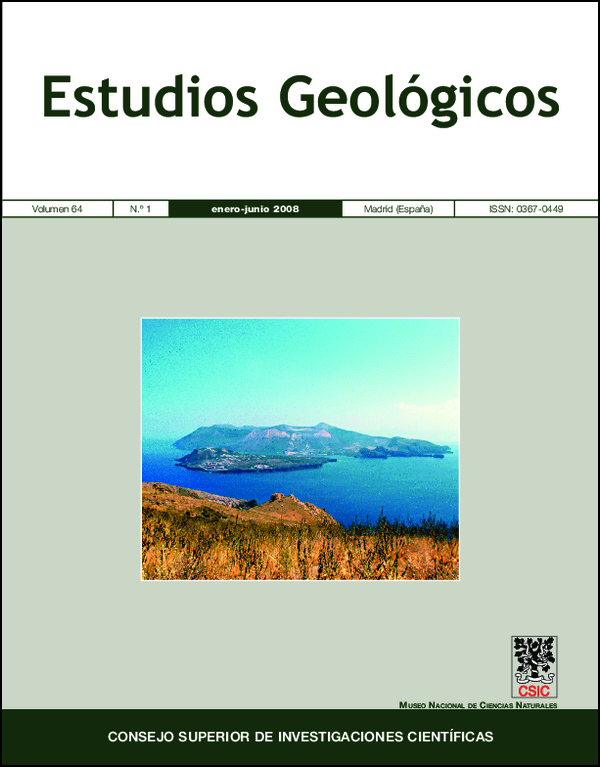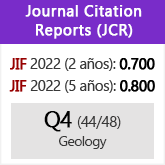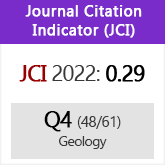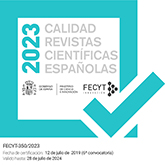Mezcla de magmas en Vulcanello (Isla Vulcano, Italia)
DOI:
https://doi.org/10.3989/egeol.08641458Palabras clave:
Shosonitas, latitas, mezcla de magmas, Vulcano, ItaliaResumen
La actividad volcánica de Isla Vulcano comienzó aproximadamente hace 350.000 años y continúa hasta la actualidad con el desarrollo de tres grandes episodios correspondientes a las caldera de Piano, caldera de Fossa y a Vulcanello, que han emitido piroclastos y coladas de composiciones muy variadas, desde riolitas a traquibasaltos. Esta variedad litológica ha sido relacionada con procesos petrogenéticos tan diversos como cristalización fraccionada, asimilación simultánea con cristalización (ACF), mezcla de magmas, etc.
El episodio de Vulcanello emite rocas traquiandesíticas, con composiciones shoshoníticas y latíticas. Un proceso de mezcla de magmas es reconocido entre traquitas y shoshonitas para generar latitas. Traquitas y riolitas son producidas por procesos de cristalización fraccionada simple y por ACF con asimilación de rocas sedimentarias a partir de magmas traquiandesíticos.
Descargas
Citas
Barberi, F., Gandino, A., Gioncada, A., La Torre, P., Sbrana, A. & Zenucchini, C. (1994). The deep structure of the Eolian arc (Filicudi-Panarea-Vulcano sector) in light of gravity, magnetic and volcanological data. Journal of Volcanology and Geothermal Research, 61: 189-206. doi:10.1016/0377-0273(94)90003-5
Beccaluva, L., Gabbianelli, G., Lucchini, F., Rossi, P.L. & Savelli, C. (1985). Petrology and K/Ar ages of volcanic dredged from the Eolian seamounts:implications for geodynamic evolution of the southern Tyrrhenian sea. Earth and Planetary Science Letters, 74: 187-208. doi:10.1016/0012-821X(85)90021-4
Carbonin, S. & Menegazzo, G. (1996). Teaching application of an X-ray powder diffraction data card file: XRD profile simulation and hanawalt index tabulation. Computers and Geosciences, 22: 935-942. doi:10.1016/S0098-3004(96)00048-9
Carr, M.J. (1994). IGPETWIN: Igpet for Windows petrology software. Somerset, Terra Softa Inc.
Castellet y Ballarà, G., Crescenzi, R., Pompili, A. & Trigila, R. (1982). A petrological model on magma evolution of Volcano eruptive complex (Aeolian Islands Italy). In: The Comparative Study of the Planets (Coradini, A. & Fulchignoni, M., eds.). NATO Advanced Study Institutes Series, D. Dordrecht, Reidel, 459-476.
Clocchiatti, R., Del Moro, A., Gioncada, A., Joron, J.L., Mosbash, M., Pinarelli, L. & Sbrana, A. (1994). Assesment of a shallow magmatic system: the 1888-1890 eruption, Vulcano Island, Italy. Bulletin of Volcanology, 56: 466-486. doi:10.1007/BF00302828
Crisci, G.M., De Rosa, R., Esperanca, S., Mazzuoli, R. & Sonnino, M. (1991). Temporal evolution of a three component system: the island of Lipari (Aeolian arc,South Italy). Bulletin of Volcanology, 53: 207-221. doi:10.1007/BF00301231
De Astis, G., La Volpe, L., Peccerillo, A. & Civetta, L. (1997). Volcanological and petrological evolution of Vulcano island (Aeolian Arc southern Tyrrehenien Sea). Journal of Geophysical Research, 102: 8021- 8050. doi:10.1029/96JB03735
De Astis, G., Peccerillo, A., Kempton, P.D., La Volpe, L. & Wu, T.W. (2000). Transition from calc-alkaline to potassium-rich magmatism in subduction environments: geochemical and Sr, Nd, Pb isotopic constraints from the island of Vulcano (Aeolian arc) . Contributions to Mineralogy and Petrology, 139: 684-703. doi:10.1007/s004100000172
De Fino, M., La Volpe, L. & Piccarreta, G. (1991). Role of magma mixing during the recent activity of La Fossa di Vulcano (Aeolian Islands, Italy). Journal of Volcanology and Geothermal Research, 48: 385-398. doi:10.1016/0377-0273(91)90053-3
Ellam, R.M., Menzies, M.A., Hawkesworth, C.J., Leeman, W.P., Rosi, M. & Serri, G. (1988). The transition from calc-alkaline to potassic orogenic magmatism in the Aeolian Islands. Southern Italy. Bulletin of Volcanology, 50: 386-398. doi:10.1007/BF01050638
Ellam, R.M. & Harmon, R.S. (1990). Oxygen isotope constraints on the crustal contribution to the subduction related magmatism of the Aeolian Islands, southern Italy. Journal of Volcanology and Geothermal Research, 44: 105-122. doi:10.1016/0377-0273(90)90014-7
Faraone, D., Molin, G. & Zanazzi, P.F. (1988). Clinopyroxenes from Vulcano (Aeolian Islands, Italy): Crystal chemistry and cooling history. Lithos, 22: 113-126. doi:10.1016/0024-4937(88)90020-5
Ferrucci, F., Gaudiosi, G., Milano, G., Nercessarian, A., Valardo, G. & Luongo, G. (1991). Seismological exploration of Vulcano (Aeolian Islands, southern Tyrrhenian Sea): case history. Acta Vulcanologica, 1: 143-152.
Francalanci, L., Taylor, S.R., McCulloch, M.T. & Woodhead, J. (1993). Geochemical and isotopic variations in the calc-alkaline rocks of Aeolian arc, southern Tyrrhenian Sea, Italy: constraints on magma genesis. Contributions to Mineralogy and Petrology, 113: 300-313. doi:10.1007/BF00286923
Frazzetta, G., La Volpe, L. & Sheridan, M.F. (1983). Evolution of the Fossa Cone Vulcano. Journal of Volcanology and Geothermal Research, 17: 329-360. doi:10.1016/0377-0273(83)90075-6
Frezzotti, M.L., Peccerillo, A., Zanon, V. & Nikogossian, I. (2004). Silica-rich melts in quartz xenoliths from Vulcano Island and their bearing on processes of crustal anatexis and crust-magma interaction beneath the Aeolian arc, southern Italy. Journal of Petrology, 45: 3-26. doi:10.1093/petrology/egg080
Giancada, A., Clochiatti, R., Sbrana, S., Botazzi, P., Massare, D. & Ottolini, L. (1998). A study of melt inclusions at Vulcano (Aeolian Islands,Italy): Insights in the primitive magmas and on the volcanic feeding system. Bulletin of Volcanology, 60: 286-306. doi:10.1007/s004450050233
Govindaraju, K. & Mevelle, G. (1987). Fully automated dissolution and separation methods for inductively coupled plasma atomic emission spectrometry rock analysis application to the determination of rare elements. Journal of Analytical Atomic Spectrometry, 2: 615-621. doi:10.1039/ja9870200615
Irvine, T.N. & Baragar, W.R.A. (1971). A guide to the chemical classification of the common volcanic rocks. Canadian Journal of Earth Sciences, 8: 523-548.
Keller, J. (1980). The Island of Vulcano. Rendiconti della Societa Italiana di Mineralogia e Petrologia, 36: 369-414.
Le Bas, M.J. (1962). The role of aluminium in igneous clinopyroxenes with relation to their parentage. American Journal of Science, 260: 267-288.
Le Maitre, R.W. (1984). A proposal by the IUGS subcommission on the systematic of igneous rocks for a chemical classification of volcanic rocks based on the total alkali silica (TAS) diagram, Australian Journal of Earth Sciences 31: 243-255. doi:10.1080/08120098408729295
Loucks, R.R. (1996). A precise olivine-augite Mg-Fe exchange geothermometer. Contributions to Mineralogy and Petrology, 125: 140-150. doi:10.1007/s004100050211
Milano, G., Ferrucci, F. & Guerra, G. (1989). Interpretazione preliminare di profili DSS del Tirreno Meridionali. Atti dell VIII Convegno Annuale del Gruppo Nazionale di Geofisica della Terra Solida, 525-533.
Peccerillo, A., Frezzotti, M.L., De Astis, G. & Ventura, G. (2006). Modelling the magma plumbing system of Vulcano (Aeolian Islands,Italy) by integrated fluidinclusion geobarometry, petrology and geophysics. Geology, 34: 17-20. doi:10.1130/g22117.1
Streckeisen, A.L. (1967). Classification and nomenclature of igneous rocks. Final report of an inquiry. Neues Jahrbuch fu.r Mineralogie, Abhandlungen, 107: 144-240.
Ventura, G. (1994). Tectonics, structural evolution and caldera formation in Vulcano Island (Aeolian Archipielago, southern Tyrrhenian Sea). Journal of Volcanology and Geothermal Research, 60: 207-224. doi:10.1016/0377-0273(94)90052-3
Vetere, F., Behrens, H., Misiti, V., Ventura, G., Holtz, F., De Rosa, R. & Deubener, J. (2007). The viscosity of shoshonitic melts (Vulcanello Peninsula,Aeolian Islands.Italy): Insight on the magma ascent in dikes. Chemical Geology 245: 89-102. doi:10.1016/j.chemgeo.2007.08.002
Descargas
Publicado
Cómo citar
Número
Sección
Licencia
Derechos de autor 2008 Consejo Superior de Investigaciones Científicas (CSIC)

Esta obra está bajo una licencia internacional Creative Commons Atribución 4.0.
© CSIC. Los originales publicados en las ediciones impresa y electrónica de esta Revista son propiedad del Consejo Superior de Investigaciones Científicas, siendo necesario citar la procedencia en cualquier reproducción parcial o total.Salvo indicación contraria, todos los contenidos de la edición electrónica se distribuyen bajo una licencia de uso y distribución “Creative Commons Reconocimiento 4.0 Internacional ” (CC BY 4.0). Puede consultar desde aquí la versión informativa y el texto legal de la licencia. Esta circunstancia ha de hacerse constar expresamente de esta forma cuando sea necesario.
No se autoriza el depósito en repositorios, páginas web personales o similares de cualquier otra versión distinta a la publicada por el editor.

















